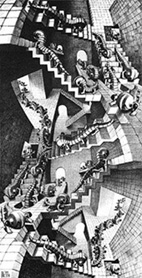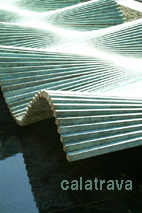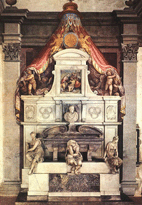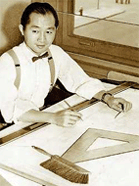|
         
|
Departamento de
Dibujo
|
|
Año Académico
2002/2003
|
|
Título |
| |
|
|
|
|
|
Tindón de Izu, Alfonso
|
|
| Jefe de Dpto. |
A33EC000010854
|
|
|
Arquitecto Técnico |
|
García Moral,
Beatriz
|
|
|
|
Bellas Artes |
|
Jiménez Hernández,
M. Jesús
|
|
IES E.F.Sanz [invitado] |
|
Bellas Artes |
|
Juan Bejarano, Bernardo
|
|
IES E.F.Sanz [invitado] |
|
Bellas Artes |
|
|
|
| |
 |
|
 ESCHER
ESCHER
Biography . Maurits Cornelis
Escher was born on June 17, 1898 in Leeuwarden, Netherlands. At a young age, Escher
was encouraged by his father to learn carpentry and other craft skills. Though he
was not a very good student in general, his artistic talent was apparent early in
his schooling. He was encouraged by his family and friends to pursue this interest
in a regular career, namely architecture. Once at the School for Architecture and
Decorative Arts, however, Escher realized that his true passion lay in the graphic
arts. He spent the next two years at art school, where he mastered graphic and woodcutting
techniques. Upon completion of his schooling, he traveled extensively through Southern
France, Spain and Italy. During these travels, he garnered numerous inspirations
for his work.
Throughout his career as an artist, Escher was fascinated by the art of structure.
Though his early work tended toward realistic portrayals of the landscape and architecture
observed during his travels, it reflected a greater fascination for structural constructs
than for the landscape itself. Escher visited the Alhambra in Granada several times,
as he was captivated by the Moorish ornamentations that filled the entire space on
the walls. The inspiration there lay the foundation for his work after 1937, for
which he is most famous. These works involve repeated patterns and regular divisions
of the plane, impossible constructions, and infinite space. His work from then until
his death in 1972 was driven by a unique understanding of mathematical concepts.
Through his wondrous creations, Escher was able to lay a symbolic bridge between
the realms of art and science
|
|

|
| |
|
|
 Biografía. Mauritius Cornelius
Escher nació un 17 de junio de 1898 en Leeuwarden, Holanda. Ya a una edad
temprana su padre le anima a estudiar ebanistería y otros oficios. Aunque
nunca fue un buen estudiante su talento artístico se hizo evidente desde el
inicio de su educación. Su familia y amigos trataron de convencerle para que
explotara su talento y lo desarrollase enmarcándolo en unos estudios reglados,
siendo la carrera idónea Arquitectura. Una vez matriculado en la Escuela de
Arquitectura y Artes Decorativas, descubrió que su verdadera vocación
le conducía irremisiblemente a las Artes Gráficas. Los dos años
siguientes estudió en una escuela de Bellas Artes donde destacó en
la talla de madera y el grafismo. Al finalizar sus estudios viajó al sur de
Francia, España e Italia. En el transcurso de sus viajes atesoró experiencias
vitales que le sirvieron de inspiración para su trabajo posterior. A lo largo
de toda su carrera artística nunca le abandonó la fascinación
por el arte de la estructura. Aunque sus primeros trabajos tendían a la representación
realista de la arquitectura y los paisajes que habían quedado grabados en
su retina durante sus viajes, ya preconizaban un mayor interés por los constructos
estructurales que por los exteriores. Visitó la Alhambra de Granada en repetidas
ocasiones ya que la ornamentación árabe que cubría las paredes
le había cautivado. Las bases ya estaban sentadas para el trabajo que desarrollaría
a partir de 1937 y por el que es más conocido. Incluye divisiones regulares
del plano, diseños de teselas, figuras imposibles, y la representación
del espacio infinito. Su obra desde 1937 hasta su muerte en 1972 se caracterizó
per una comprensión única de los conceptos matemáticos. A través
de sus mágicas creaciones Escher consiguió tender un puente simbólico
entre el Arte y la Ciencia. Biografía. Mauritius Cornelius
Escher nació un 17 de junio de 1898 en Leeuwarden, Holanda. Ya a una edad
temprana su padre le anima a estudiar ebanistería y otros oficios. Aunque
nunca fue un buen estudiante su talento artístico se hizo evidente desde el
inicio de su educación. Su familia y amigos trataron de convencerle para que
explotara su talento y lo desarrollase enmarcándolo en unos estudios reglados,
siendo la carrera idónea Arquitectura. Una vez matriculado en la Escuela de
Arquitectura y Artes Decorativas, descubrió que su verdadera vocación
le conducía irremisiblemente a las Artes Gráficas. Los dos años
siguientes estudió en una escuela de Bellas Artes donde destacó en
la talla de madera y el grafismo. Al finalizar sus estudios viajó al sur de
Francia, España e Italia. En el transcurso de sus viajes atesoró experiencias
vitales que le sirvieron de inspiración para su trabajo posterior. A lo largo
de toda su carrera artística nunca le abandonó la fascinación
por el arte de la estructura. Aunque sus primeros trabajos tendían a la representación
realista de la arquitectura y los paisajes que habían quedado grabados en
su retina durante sus viajes, ya preconizaban un mayor interés por los constructos
estructurales que por los exteriores. Visitó la Alhambra de Granada en repetidas
ocasiones ya que la ornamentación árabe que cubría las paredes
le había cautivado. Las bases ya estaban sentadas para el trabajo que desarrollaría
a partir de 1937 y por el que es más conocido. Incluye divisiones regulares
del plano, diseños de teselas, figuras imposibles, y la representación
del espacio infinito. Su obra desde 1937 hasta su muerte en 1972 se caracterizó
per una comprensión única de los conceptos matemáticos. A través
de sus mágicas creaciones Escher consiguió tender un puente simbólico
entre el Arte y la Ciencia. |
|
 |
| |
|
|
 VASARI VASARI
Biography. Italian
writer, painter, and architect, best known for his book on the lives of major Italian
Renaissance artists, Vasari was born on July 30, 1511, in Arezzo. Trained in art
as a child, he went to Florence, where he worked in the studio of Andrea del Sarto and won the patronage of the Medici family. Among Vasari's major
surviving paintings are murals in the Palazzo Vecchio, Florence, and the Vatican
in Rome. As an architect Vasari was a follower of his brilliant contemporary Michelangelo. Among the important buildings he designed
are the Palazzo degli Uffizi in Florence, now a museum, and a number of palaces and
churches in Pisa and Arezzo.
It is as a writer, however, that he is most famous. His Lives of the Artists (1550,
revised 1568; trans. 1912-14, 10 vol.), one of the earliest works on art written
by an artist of merit, is a primary source of information about the artists of the
Italian Renaissance. The revised edition includes his autobiography in addition to
the lives of Michelangelo and other major painters of the time. Vasari's book offers
his personal evaluation of the works of these artists, as well as discussions on
the state of the arts. His easy, natural writing style helped to make his book one
of the most enduring of art histories. He died in Florence on June 27, 1574. |
|

|
|
|
|

|
|
Fundación
Germán Sánchez
|
|
Ruipérez
|
|
|
|
|

|

|
|
Residencia de Estudiantes
|
|
|
Yo no soy yo.
Soy este
que va a mi lado sin yo verlo,
que, a veces, voy a ver,
y que, a veces olvido.
El que calla, sereno, cuando hablo,
el que perdona, dulce, cuando odio,
el que pasea por donde no estoy,
el que quedará en pie cuando yo muera.
JRJ
|
|

|
|
 |
|
|
Proyecto "Arte
y Técnica, valga la redundancia..."
|
|
|
|

|